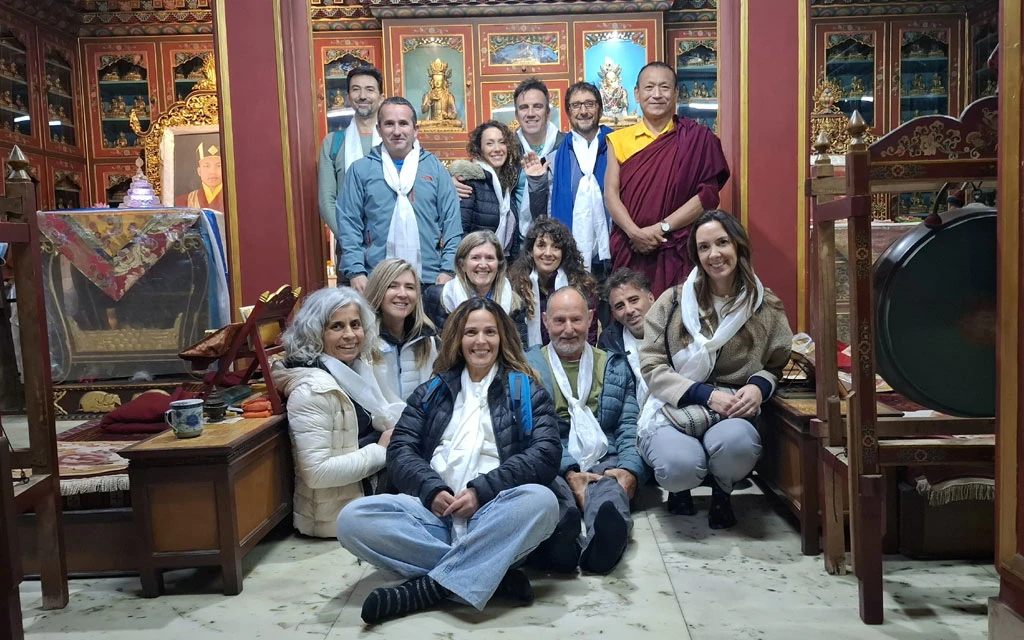Imagine waking up to the crisp mountain air, surrounded by snow-capped peaks, as you begin your day with a peaceful yoga session. The Annapurna Base Camp Yoga Trek is not just a journey through the Himalayas but also a soulful adventure that blends trekking, yoga, and the magic of Nepal’s breathtaking landscapes.
Your adventure begins with a scenic drive from Kathmandu to Pokhara, a lakeside city where the mountains reflect on the tranquil waters of Phewa Lake. From there, the real journey starts as you drive to Nayapul. You will then begin trekking through charming villages and terraced fields, reaching Ulleri. It is a cozy hillside stop where the first whispers of the mountains greet you.
The next day, the trail winds through lush rhododendron forests, leading you to Ghorepani. It is a picturesque village perched high in the hills. You will hike up to Poon Hill early in the morning. The sunrise paints the sky in golden hues, illuminating the Annapurna and Dhaulagiri ranges in a breathtaking spectacle. After soaking in the views, you descend through forests alive with birdsong, arriving at Tadapani.
As you continue deeper into the Annapurna Sanctuary, the landscape shifts into bamboo forests that give way to rugged trails, and the air grows crisper. You pass through Sinuwa and climb to Deurali. The valley narrows, and the peaks tower above. Then comes the highlight: the trek to Annapurna Base Camp. It is a high-altitude amphitheater surrounded by some of the world’s tallest mountains.
After a night under the stars, you descend through Bamboo, where the forest envelops you in green tranquility. The final stretch leads to Jhinu Danda, where natural hot springs await, offering the perfect reward for your efforts. The journey ends with a drive back to Pokhara.
Why Annapurna Base Camp Yoga Trek?
Picture yourself breathing in crisp mountain air, your body energized by trekking, your mind at peace with meditation, and your soul awakened by the raw beauty. This is what makes the Annapurna Base Camp Yoga Trek a transformative journey. It is not just a trek but a moving meditation in one of the most breathtaking landscapes on Earth.
Annapurna Base Camp Yoga Trek is a harmonious balance of physical challenge and inner calm.
The combination of trekking and yoga helps you build strength, flexibility, and mindfulness, making every step a mindful experience.
You will pass through rhododendron forests, cross swinging suspension bridges, and explore traditional Gurung villages where time seems to stand still.
Practicing yoga amidst these ancient peaks deepens your connection with nature, allowing you to truly unplug and recharge.
Staying in teahouses and sharing meals with locals adds a layer of cultural richness to your trek.
What to Expect on the Annapurna Base Camp Yoga Trek
The Annapurna Base Camp Yoga Trek is a journey that awakens all your senses, where every day begins with sunlit yoga sessions. Expect to walk through ever-changing landscapes, from lush rhododendron forests and terraced farmland.
Your mornings will start with guided yoga and meditation, preparing both body and mind for the day’s trek. While your afternoons will be filled with scenic hikes through traditional Gurung villages, where the warm hospitality of locals makes you feel at home. As you ascend higher, the air thins, the temperatures drop, and the views become more dramatic. You will finally reach Annapurna Base Camp, standing in an amphitheater of towering giants like Annapurna I and Machapuchare (Fishtail).
Along the way, you will soak in natural hot springs, sip steaming cups of Nepali tea, and fall asleep to the silence of the mountains. This trek is not just about reaching a destination; it is about slowing down, breathing deeply, and immersing yourself in the raw beauty and serenity of the Himalayas.
Best time for the Annapurna Base Camp Yoga Trek
The ideal time for the Annapurna Base Camp Yoga Trek is during spring (March to May) and autumn (September to November). In spring, the trails come alive with blooming rhododendrons painting the hills in shades of red and pink, while crisp autumn skies offer unmatched clarity for panoramic mountain views.
These seasons provide stable weather, comfortable daytime temperatures for trekking, and chilly but bearable nights. While winter (December to February) brings quieter trails and snow-dusted peaks, colder conditions require extra preparation. Monsoon season (June to August) sees lush landscapes but slippery trails and frequent rain, making it less ideal.
For the ultimate blend of pleasant weather, breathtaking scenery, and rejuvenating yoga under open skies, spring and autumn stand out as the golden windows to experience this Himalayan adventure.





